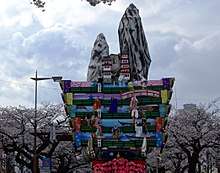Hitachi Furyumono
The Hitachi Furyumono (日立風流物) is a parade in Hitachi city, Japan.[1] It is held during Hitachi Sakura Matsuri (日立さくらまつり), the annual cherry blossom festival in April, and the Great Festival at the local Kamine Shrine once in every seven years in May.[1][2] It is inscribed on the UNESCO Intangible Cultural Heritage Lists as a part of "Yama, Hoko, Yatai, float festivals in Japan", 33 traditional Japan festivals.[3][4]

Parade
Furyumono is a puppet show performed onstage on the floats.[5] Each of four local communities - Kita-machi (北町), Higashi-machi (東町), Nishi-machi (西町) and Moto-machi (元町) - has their own float.[1] During the annual festival, one community presents its parade float each year.[1] During the Great Festival at Kamine Shrine, the four communities compete for the most skilled puppeteers and the best hospitality to the local deity.[1]
The floats are five tons in weight, 15 meters in height, and from 3 to 8 meters in width.[6] Each of them has a five-storied stage, and on each stage puppets play a scene of one story respectively.[5]
Each puppet is controlled by three to five puppeteers manipulating the ropes.[1]
History
The origin of the parade goes back to 1695.[5] According to Kamine Shrine, Tokugawa Mitsukuni, the second lord of Mito Domain, appointed Kamine Shrine as the Sou-Chinju, the local tutelary shrine.[7] People held religious festivals and dedicated floats to the shrine.[5]
In the early 18th century, a puppet show began supposedly imitating Ningyō jōruri, the puppet theater with chanted narration that was very popular in Edo and Osaka area at that time.[5]
In 1945, most of the floats were lost in the war disasters, but Furyumono was restored in 1958.[5] In addition, the existing float was registered as the Important Tangible Folk Cultural Property in 1959.[8]
In 1977, Furyumono was registered as the Important Intangible Folk Cultural Property.[6]
In 2009, it was inscribed on the UNESCO Intangible Cultural Heritage Lists with the Yamahoko parade of Gion Matsuri.[4] In 2016, these two parades and 31 traditional festivals were registered on the UNESCO Intangible Cultural Heritage Lists[4] as "Yama, Hoko, Yatai, float festivals in Japan", the representative examples showing the diversity of Japan local cultures.[3]
References
- "Hitachi Furyumono". Intangible heritage. UNESCO. 2008. Retrieved 2018-06-28.
- "風流物、無形文化遺産に登録 日立で歓喜再び「伝統守る励みに」 茨城". Sankei News (in Japanese). Sankei Shinbun. 2016-12-02. Retrieved 2018-06-28.
- "Yama, Hoko, Yatai, float festivals in Japan". UNESCO. Retrieved 2018-06-28.
- "UNESCO panel recommends adding 33 Japan festivals to heritage list". the Japan Times. 2016-11-01. Retrieved 2018-06-28.
- Hyotan Editors Club, ed. (2005), Hyotan No.158 (PDF), Hitachi International Committee, retrieved 2018-06-29
- "日立風流物" [Hitachi Furyumono]. 文化遺産オンライン [Cultural Heritage Online]. 無形民俗文化財 (in Japanese). Agency for Cultural Affairs. Retrieved 2018-06-28.
- "大祭禮". Kamine Shrine's official Site (in Japanese). Retrieved 2018-06-29.
- "日立風流物" [Hitachi Furyumono]. 文化遺産オンライン [Cultural Heritage Online]. 有形民俗文化財 (in Japanese). Agency for Cultural Affairs. Retrieved 2018-06-28.
Further reading
- Thornbury, B.E. (1997). The Folk Performing Arts: Traditional Culture in Contemporary Japan. Suny Series in Contemporary. State University of New York Press. p. 18. ISBN 978-0-7914-3255-6.
External links
- 日立風流物の歴史 (The history of Hitachi Furyumono) - Hitachi tourism & products Association
- 日立風流物 - Kotobank, the Japanese online dictionary
- 大祭禮, 神峰神社 (The Grand Festival, Kamine shrine) - the official site of Kamine shrine
- 日立市郷土博物館 (Hitachi City Museum) - the local museum, which has a permanent space for Hitachi Furyumono
